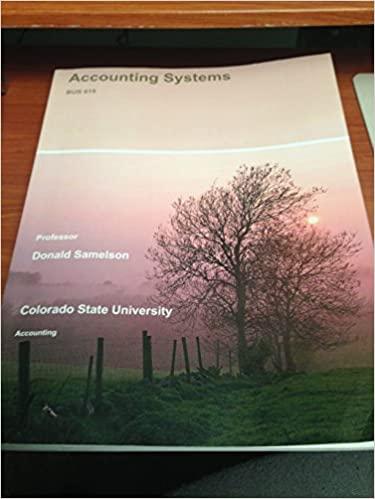Question
Cantil Creamery Inc. Cantil Creamery, Inc. (CCI) owned and operated 14 retail ice-cream stores spread throughout Southern California, from San Luis Obispo to San Diego.
Cantil Creamery Inc. Cantil Creamery, Inc. (CCI) owned and operated 14 retail ice-cream stores spread throughout Southern California, from San Luis Obispo to San Diego. CCIs stores sold only the highestquality, ultra-premium ice cream. They offered 25 different ice-cream flavours. Many of the CCI flavour were exotic such as Polynesian Fantasy, Mango Lemon Supreme, and Multi-Nut Twist But CCI also sold a few traditional ice cream flavours, such as vanilla, chocolate, strawberry, and coffee. Some of the flavours were very popular, but a few of the exotic flavours sold in low volumes. CCI produced its own ice cream. Originally the ice cream was produced in the garage of the companys founder, Will Forgey. But the company outgrew the garage, and will had since leased a building to house CCIs production activities. As CCI had grown, Will had been able to afford more expensive, automated manufacturing equipment that blended the flavours and packaged the liquid ice-cream in preparation for freezing. CCIs most significant production costs were for raw materials, particularly cream, sugar, and the special flavour ingredients, and for the acquisition, operation, and maintenance of the production equipment. All of CCIs products were sold at the same retail price. Will set the prices to yield, roughly, a markup of 100 percent on average full production costs. CCIs 2004 budget included manufacturing overhead of $600,000. to estimate product costs. Will spread this overhead cost to products based on a proportion of the direct labour used in the production process. CCIs total direct labour cost for 2004 was $300,000. so Will charged the overhead to products at a rate of 200 percent of direct labour costs. One day in a casual conversation, Louise Fettinger, Wills neighbour and a controller of a small manufacturing company, suggested that Wills pricing policy was not very smart. Louises intuition was that the costs of producing CCIs various flavours were very different. She thought those differences should be reflected in the prices charged, or CCIs profits would vary as the mix of products sold varied. Louise suggested that Will re-estimate product costs using what she called an activity based cost system. Toward that end, she suggested that he identify the major activities whose costs were included in the companys overhead costs. Then he should apply those costs to products based on the products consumption of each of those activities. In response to Louises suggestion, Will prepared the information shown in Exhibit 1. Then, again following Louises suggestion, he decided to calculate the costs of two illustrative products as an experiment to see if Louises new cost system idea produced any material differences. He asked Louise to take her best guess as to where he might find the most significant differences, if any existed. After Will described the products to her, Louise suggested that he use Polynesian Fantasy and Vanilla as the test product examples. Exhibit 2 provides data pertinent to those two products. Exhibit 1 Cantil Creamery, Inc 2004 Budgeted Manufacturing Overheads Costs Activity Budgeted Cost Activity cost driver Budgeted activity Purchasing $80,000 Purchase orders 909 Material handling 95,000 Setups 1,846 Blending 122,000 Blender hrs 1,000 Freezing 175,000 Freezer hrs 1,936 Packaging 110,000 Packaging machine hrs 1,100 Quality control 18,000 Batches 286 Total mfg OH cost 600,000 Exhibit 2 Cantil Creamery, Inc Two Product Examples (2004 Data) Polynesian Fantasy Vanilla Direct material $2.00 /gallon $1.80 /gallon Direct labour 1.20/gallon 1.20/gallon Budgeted production & sales 2,000 gallons 100,000 gallons Batch size 100 gallons 2,500 gallons Setups 3 per batch 3 per batch Purchase order size 50 gallons 1,000 gallons Blender time 0.6 hr per 100 gallons 0.3 hr per 100 gallons Freezer time 1.0 hr per 100 gallons 1.0 hr per 100 gallons Packaging machine time 0.3 hr per 100 gallons 0.2 hr per 100 gallons Questions: 1. Compute the full production cost (per gallon) of the Polynesian Fantasy and Vanilla products using: a) Wills old costing method; b) The new costing method (Louises suggestion). 2. What are the effects, if any, of changing the companys costing method? Specifically, are the differences between the two costing methods material in terms of: a) Their effect on individual product costs? b) Their effect on total company profits? (Assume no changes in any operating decisions, such as prices and production volume) If there are material differences, why do they exist? If there are no material differences, why do they not exist? 3. What should Will do now? Explain.
Step by Step Solution
There are 3 Steps involved in it
Step: 1

Get Instant Access to Expert-Tailored Solutions
See step-by-step solutions with expert insights and AI powered tools for academic success
Step: 2

Step: 3

Ace Your Homework with AI
Get the answers you need in no time with our AI-driven, step-by-step assistance
Get Started


